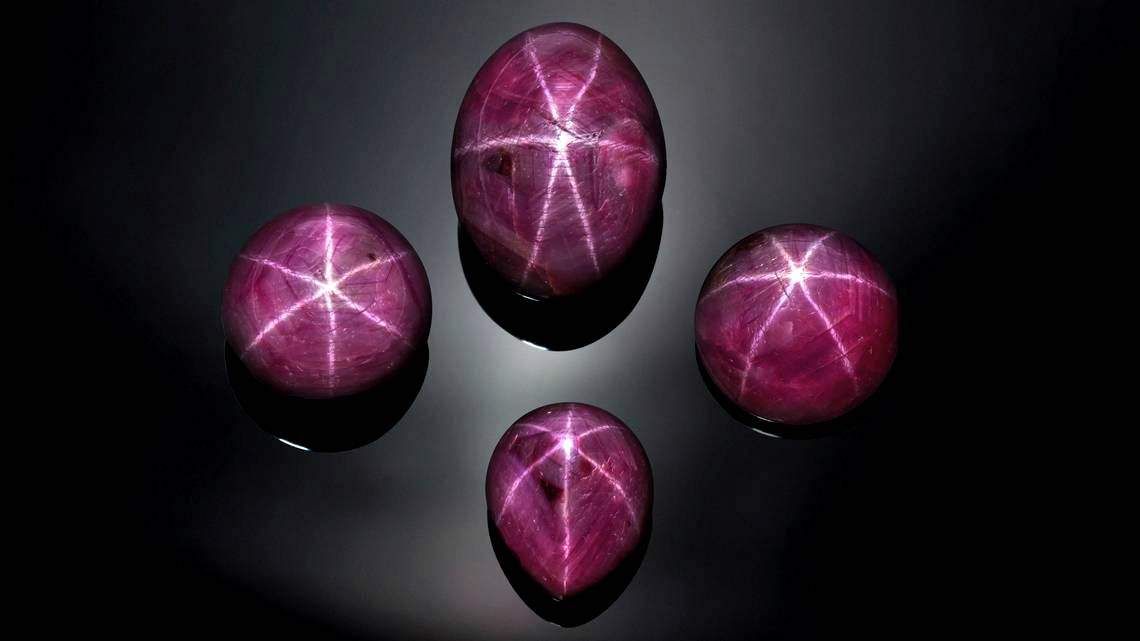

4 Rare Rubies Found in North Carolina
 | ||
| The Mountain Star Ruby collection Courtesy of Guernsey's auction houseRubies are already rarer than diamonds. But star rubies are something incredibly special. In North Carolina, a remarkable discovery was made by Jarvis Wayne Messer, when he found four rare star rubies in the Appalachian Mountains near Asheville. These stones are considered among the most valuable types of colored gemstones in the world. The collection was estimated to be worth over $90 million. In 1990, Jarvis “Wayne" Messer, a self-described “rock hound ”living in the Appalachian Mountains of western North Carolina, made an incredible discovery. While combing the native woods for naturally occurring rarities, he unearthed four rough stones that sent shivers through him.From their outward appearance, he sensed that he had come across something very special.Through the efforts of a friend who happened to be an amateur stone cutter, the true impact of Messer ’s find became evident. This mountaindest means, who worked as a trout fishing guide to provideor his family, made the discovery of a lifetime. Although Mr. Messer knew in his heart that his discovery was extraordinary, he needed scientific documentation to prove it. Unfortunately, the cost for the necessary gemological testing was well beyond his means. While contemplating his dilemma, word of the stones spread across the Appalachian hills. In short order, friends and neighbors approached Wayne. If they each "chipped in” what monies they could spare, perhaps he could pool enough to deliver his stones to New York City…to present them to the prestigious Gemological Institute of America. And so it happened that these four stones made their way to the GIA which, in detailed reports, confirmed that what Wayne had discovered were indeed remarkably large Star Rubies! A ruby is rare. A ruby with a classic six-rayed star pattern—known as a “star ruby” — is one thousand times rarer still. To find four matching star rubies is nothing short of remarkable. To find them in the United States (when star rubies have been found in the past, they have been found in Southeast Asia), is virtually unimaginable. In the simplest of terms, a “star” is formed when a stone is placed under a light. As noted above, this happens very rarely. When such stars appear, they are most often faint or somewhat fuzzy. The stars in Wayne’s four stones are vivid. Sharp and bright, when viewing them it almost seems like an internal light switch is turned on. The stars are stunning. It is a tradition that large and rare gemstones be given names;; with this in mind, Wayne's stones became known as the Appalachian Star (139.40 ct.), the Promise Star (64.16 ct.), the Misty Star (52.36 ct.), and the Smokey Mountain Two-Star (86.54 ct.) which remarkably has stars on both its top and bottom. Together, the Mountain Star Ruby Collection weighs in at a staggering 342.46 ct! By comparison, the Smithsonian Museum has on display a star ruby described as one of the world’s largest. That ruby weighs 138 ct., about a carat less than the Appalachian Star. As if the GIA reports were not enough, the stones were then shipped to London where the BGI (British Gemological Institute) confirmed the GIA’s findings. Once in England, the Natural History Museum of London, considered by some to be the finest museum of its type in the world, asked to exhibit the largest of the stones—the Appalachian Star. And quite an exhibit it was. Approximately 200,000 visitors lined up to view the extraordinary stone over a two-week period, the largest audience that fabled institution has experienced in its multi-century existence. Read also: North Carolina: Mines to Dig for Gem & Crystals in North Carolina The institution’s leading gemologist, Dr.Cally Oldershaw, described the stone as “quite breathtaking. “In the Natural History Museum of London’s Mineralogy Newsletter, Sept. 20,1992, the Appalachian Star was described as “a perfect six-rayed natural star ruby… thought to be the finest in the world.” London’s Daily Mail was more succinct referring to the stone simply as “the world’s finest ruby. The value of a ruby is typically determined based on color, cut, clarity and carat weight, but rubies also are evaluated based on their geographic origin. Ruby gets its name from the Latin word "ruber," which means red. In the Sanskrit language, ruby is called "ratnaraj," which translates to "king of gemstones."
|
Recommended Videos
 45 hotels around the world with stunning views318 views
45 hotels around the world with stunning views318 views People Rescue ‘Exotic’ Bird That Couldn’t Fly, Turns Out It’s A Seagull Covered In Curry134 views
People Rescue ‘Exotic’ Bird That Couldn’t Fly, Turns Out It’s A Seagull Covered In Curry134 views-
Advertisements
 50 Times Mother Nature Proved To Be Scary As Hell.91459 views
50 Times Mother Nature Proved To Be Scary As Hell.91459 views 50 Cardinal Birds That Are Indescribably Beautiful28761 views
50 Cardinal Birds That Are Indescribably Beautiful28761 views Hokkaido Bird Looks Like Flying Cotton Ball2090 views
Hokkaido Bird Looks Like Flying Cotton Ball2090 views Photographer Captures the Beauty of White Lions149 views
Photographer Captures the Beauty of White Lions149 views Art Zone Reveals the Incredible Beauty of 10 Hummingbirds in Vivid Close-up Shots384 views
Art Zone Reveals the Incredible Beauty of 10 Hummingbirds in Vivid Close-up Shots384 views 25 Things That Are Bigger Than You Think98242 views
25 Things That Are Bigger Than You Think98242 views




